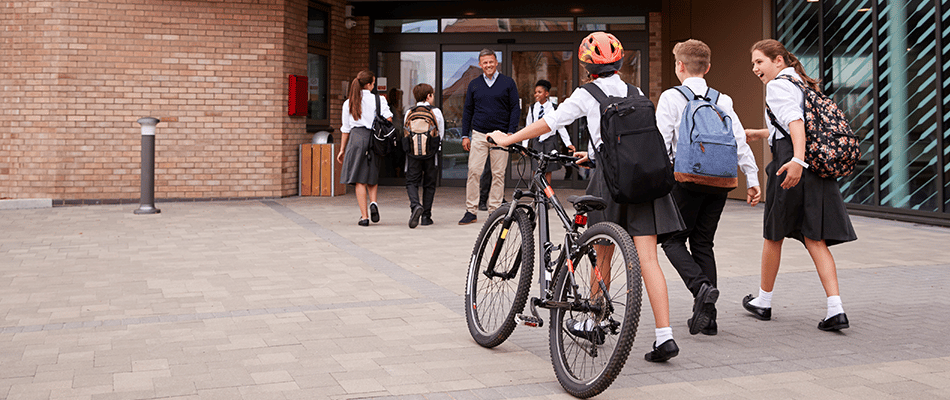ISJ Exclusive: Smart education is revitalising schools


James Thorpe
Share this content
Dahua reports on how AI is empowering a new generation of advanced, efficient security systems.
In the field of education, AI is also facilitating the digital and intelligent upgrading of schools and institutions from K12 to universities. AI applications such as smart identification, deep learning and intelligent analysis greatly reduce manpower costs, while improving the security level and management efficiency at the same time. AI-enabled innovative teaching methods can help enhance engagement in both remote and in-person classes and promote a conducive learning environment for students.
Dahua Deephub
Digitalisation in the education sector has become a global trend. With the unprecedented offline-to-online transition of many classrooms, modern interactive whiteboard and blackboard have emerged.
The Dahua DeepHub Smart Interactive Whiteboard, for instance, provides an array of features including multifunctional writing, wireless projection, conference content sharing, etc., making it an ideal learning and teaching tool for classrooms and meeting rooms where demonstration, information sharing and document management are needed.
The Dahua DeepHub offers low writing parallax for a paper-like writing experience. Contents and materials can be conveniently shared on the screen that supports nine split screens and 4K UHD. The device is equipped with built-in camera and microphone ideal for life-like face-to-face video conferencing. It supports various educational tools and offers centralised device management.
In addition, the Dahua DeepHub is not just a powerful teaching tool with display capability, but also an all-in-one solution for interactive and hybrid education. With education software solution, teachers can present their pre-made interactive courses on Dahua DeepHub. They can utilise digital education tools such as virtual ruler, protractor, etc. or even interactive games with the students for a livelier class. Students can also participate and collaborate in the classroom or at home, using their own devices, to receive content, take a quiz, project their outcomes, or write on the same canvas. In Dahua DeepHub classroom, distance and education constraints are reduced by technology.
Alternatively, consider an all-in-one smart blackboard. With highly integrated design, it combines traditional blackboard writing with the advantages of touch screen, providing interactive human-computer enjoyment for classroom.
Broadcasting and recording system
Normalcy and resource imbalance during the pandemic have prompted developing countries to accelerate hybrid teaching solutions.
With Dahua smart education solutions, teachers don’t have to worry about students who can’t participate in in-person classes. An intelligent camera such as the 8MP WizMind Classroom Network Camera can automatically track and capture a teacher’s lecture through AI algorithm. It also supports detection of class behaviours such as standing up, writing on the board, walking, etc. Broadcasting and recording server can integrate with multi-channel video streams to vividly restore the classroom scene, providing an immersive remote learning experience for students in different locations.
Preventing unauthorised entry
Campus entrances and exits are areas vulnerable to external threats. A robust entrance and exit access control system is imperative in building the school’s first major line of defence.
For example, installing an AI-enabled access control system can effectively prevent unauthorised entry into the campus, library, teaching buildings, dormitories and other school premises. Aside from that, the latest data management technology can be used to meet the daily needs of schools and students (e.g. attendance, visitors, vehicles).
Likewise, perimeter protection, the technology behind tripwire and line crossing function, plays a vital role in preventing invasions in surrounding areas or unauthorised access to regulated places. When unauthorised personnel and vehicles are detected, the system will send a real-time alarm to notify the control room, which can help eliminate security risks in the campus. Machine learning helps reduce false alarms by filtering out irrelevant objects like leaves, branches and even animals.
Real time detection
Globally, school violence and bullying remain a serious problem. A report by UNESCO and the Institute of School Violence Prevention at Ewha Womans University in Seoul, South Korea indicated that an estimated 246 million (20%) children and adolescents were subjected to some form of school violence each year. One of the recommended priority actions is to establish reporting systems and improve the collection of data and evidence.
For campus safety, today’s comprehensive security systems have already integrated emergency management features. With the help of an AI sensor, 3D cameras with stereo analysis capabilities can identify fights, falls and other possible violent behaviours through deep learning. With real-time alarm in place, the school’s security personnel can be informed in time about possible emergencies such as violence and falls, allowing them to intervene or respond accordingly. A one-button alarm system is also suggested in the campus premises to provide students with the fastest way to ask for help in case of emergencies.
Best practices
As AI becomes more advanced and continues to gain traction in the security industry, it is imperative to carry out best practices in surveillance monitoring. Educating users regarding proper usage of technology and its benefits is strongly encouraged. Aside from that, data and privacy protection must also be prioritised at all times. Several central management software and platforms combine data and privacy security functions in order to help protect privacy while monitoring.
Some of the measures being implemented are minimised data and private information, face/body mosaic technology, as well as security encryption of network transmission, storage, download and export. Users also have an option to configure the storage duration of each video channel. Overall, these best practices are put into action to help ensure privacy protection and promote responsible monitoring.
This article was originally published in the special September show edition of International Security Journal. To read your FREE digital edition, click here.



